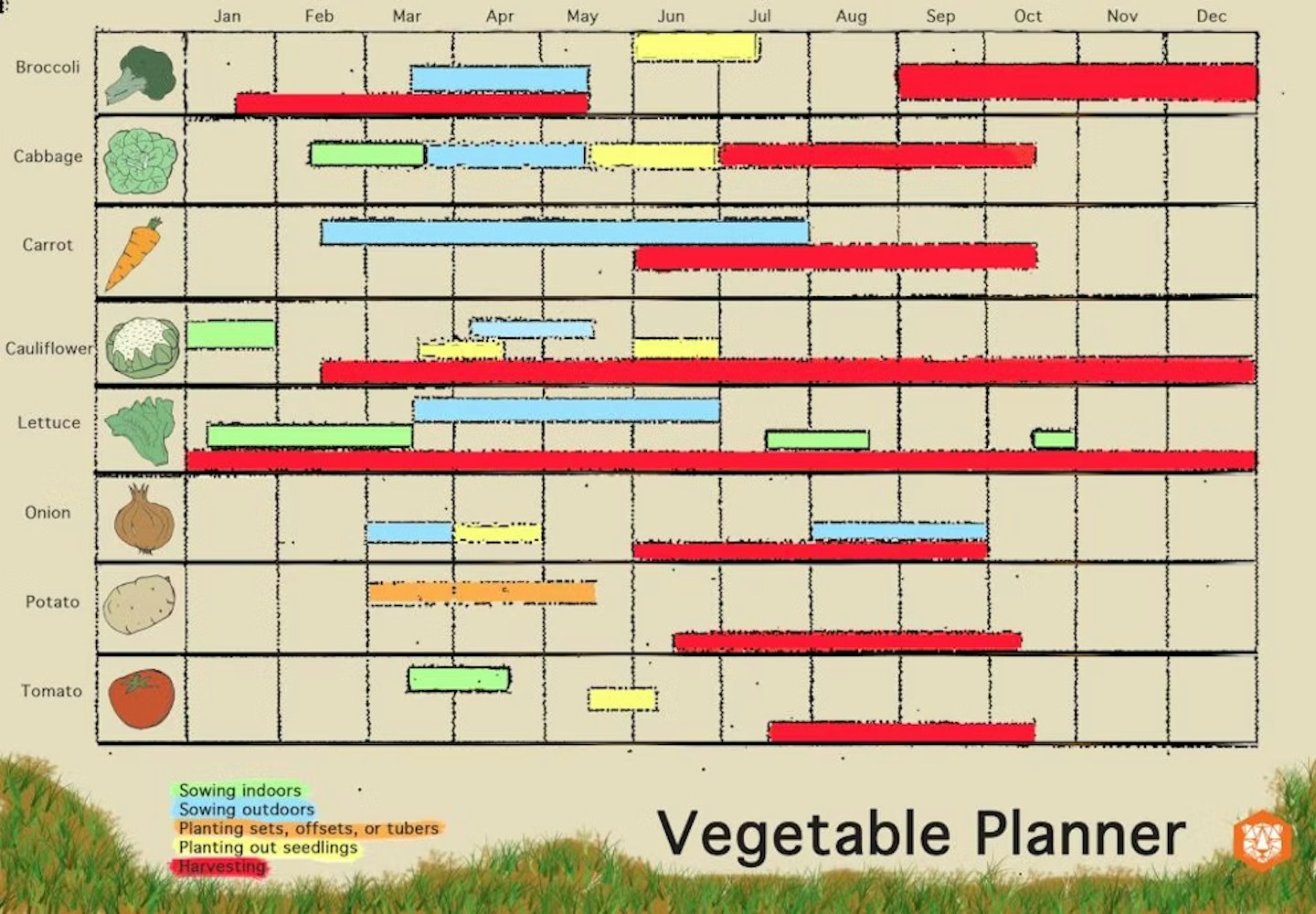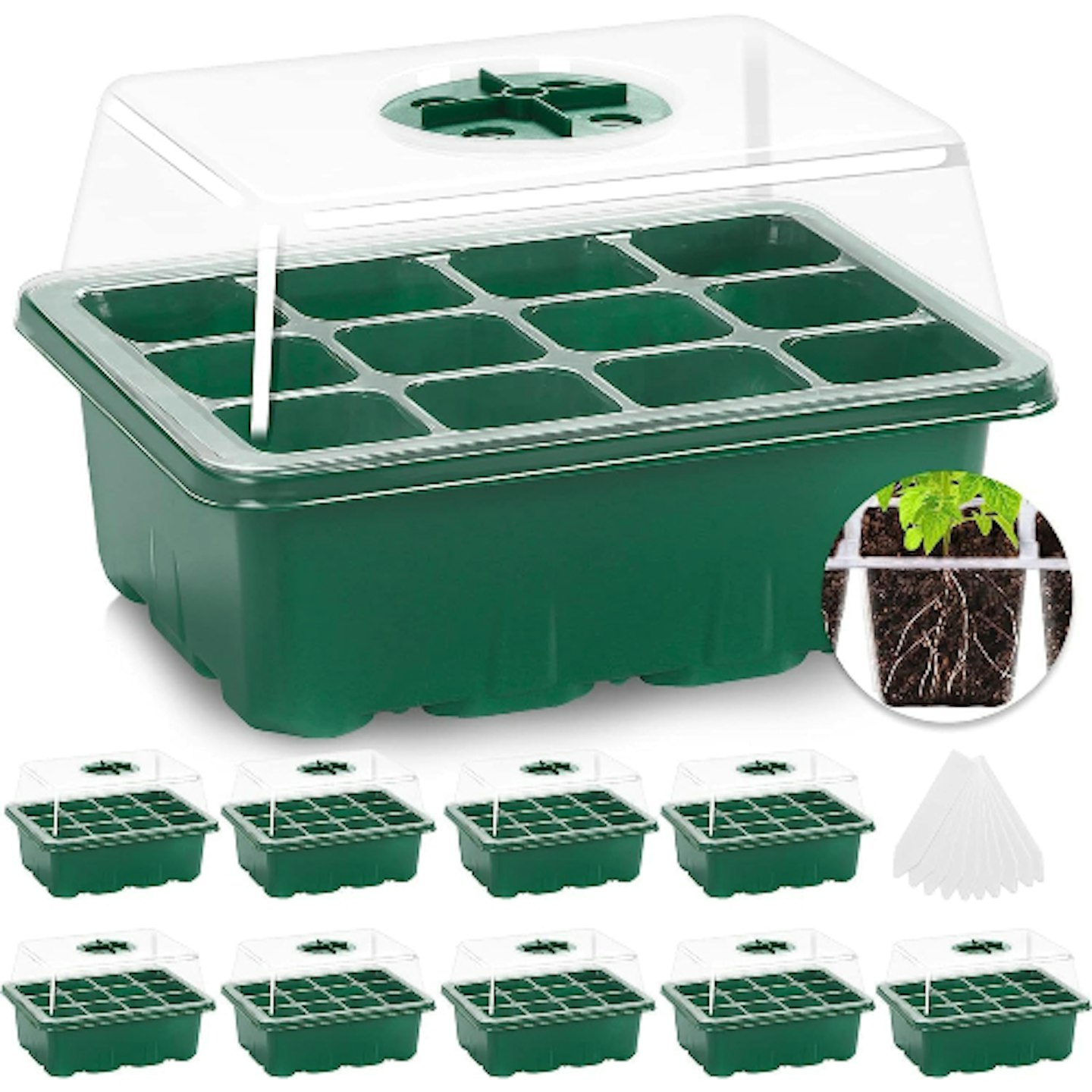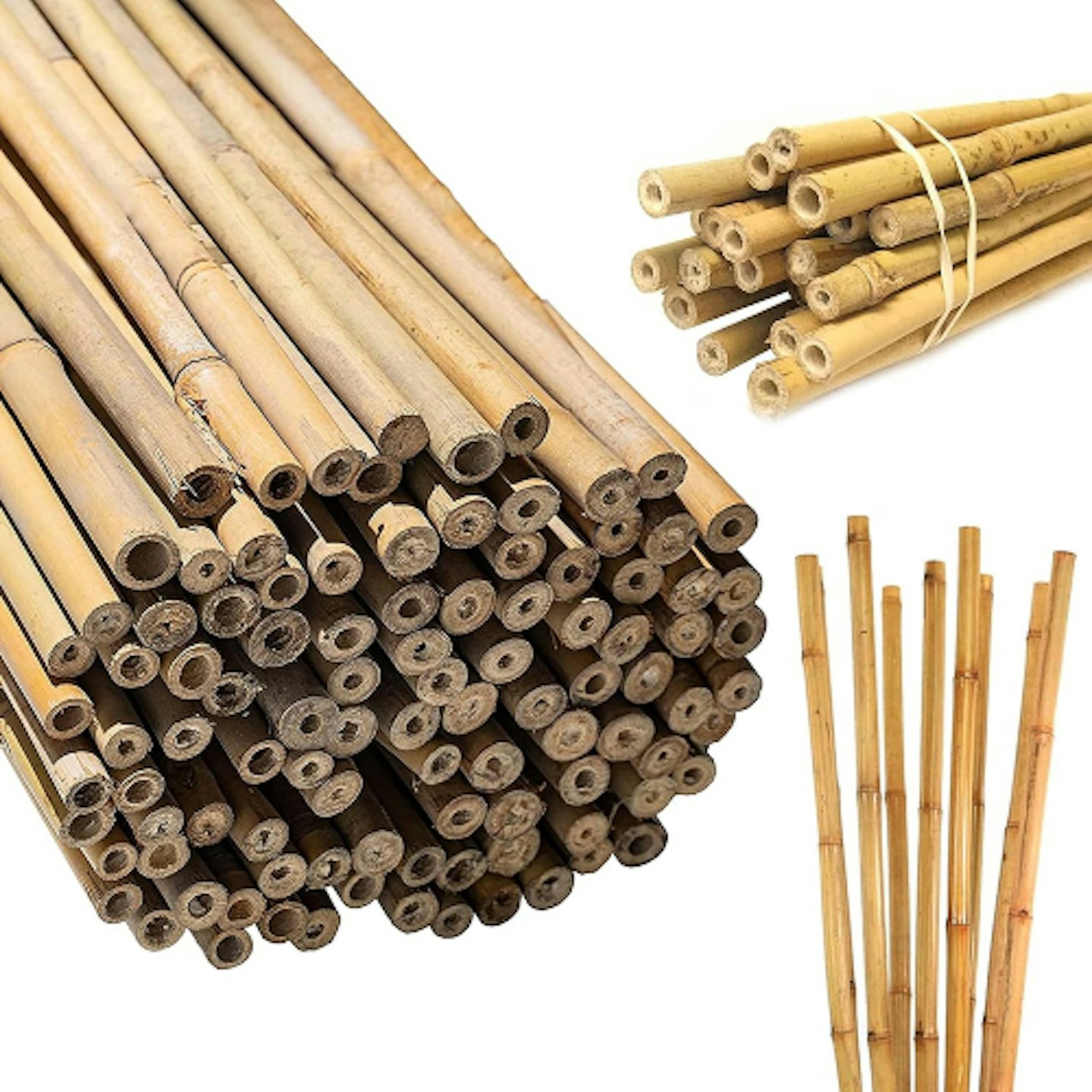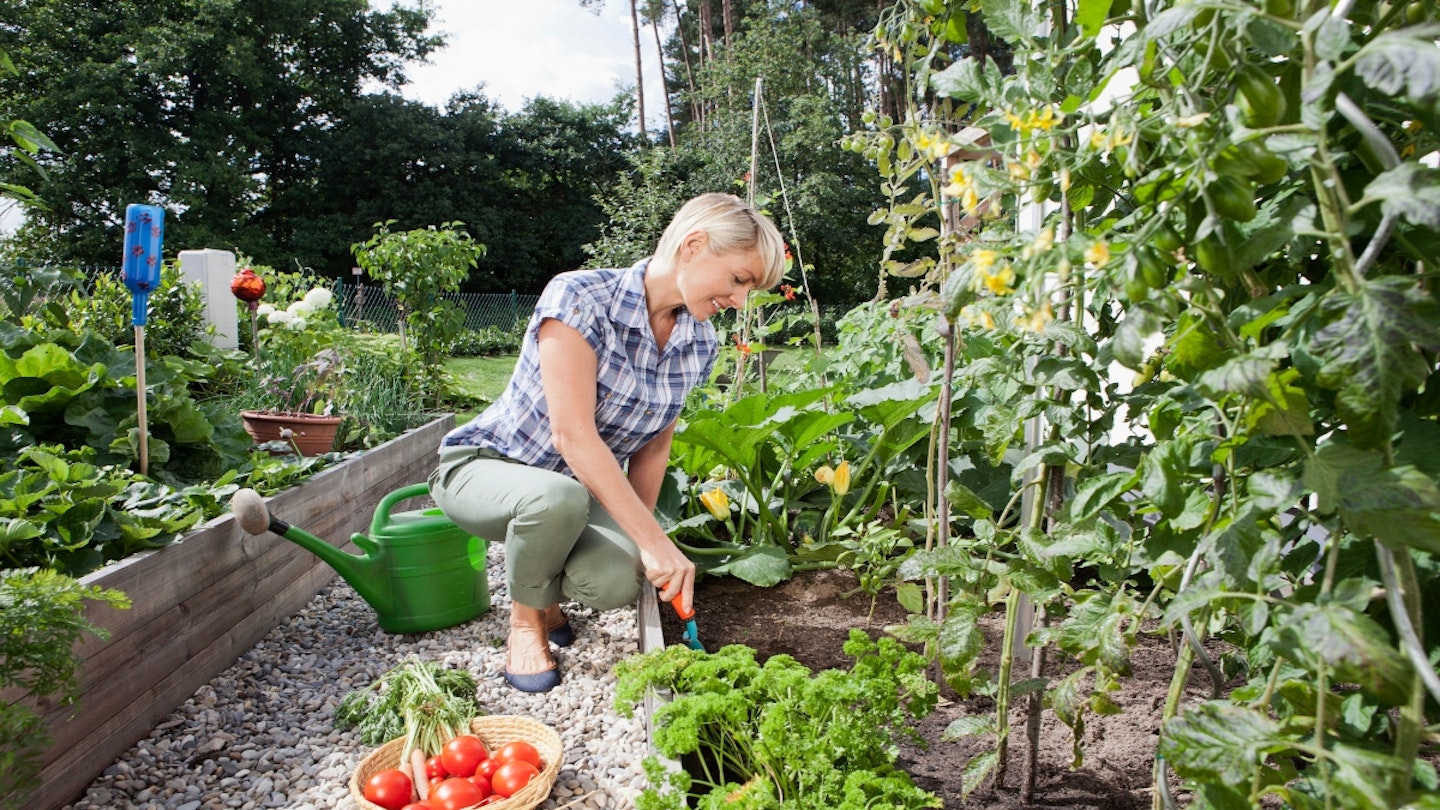There’s nothing more satisfying than the fresh taste of some homegrown veg. Growing your own veggies in your garden or allotment patch will not only allow you to have access to healthy food straight on your doorstep but will save you money on your shopping bill. It’s also fun, and more time spent in the great outdoors can have great benefits for your mental health too.
It’s important to make sure you know when to plant your vegetables, as many of them have to be sown at different times throughout the year, otherwise, you’ll be left with a sad-looking vegetable patch. Here, we give you a full guide on what vegetables you should plant and when.
When can you plant vegetables?

Most vegetables are usually sown during the spring (March to May) after the last frost, or during the warmer summer months. Harvesting will usually take place during mid-summer (although this can vary depending on the veg).
A few things to consider when growing your vegetables is that you’ll be required to sow some seeds indoors (such as tomatoes, sweetcorn, cabbages and marrows) before moving them outside.
If you’re planting your vegetables outside you can sow them either straight into the ground, in raised beds, pots and even hanging baskets.
The year-long vegetable planner above from The Hip Horticulturist clearly breaks down when you should sow your vegetable seeds indoors and outdoors and harvest your homegrown goods.
What are the best vegetables to grow for beginners?

It’s always exciting growing your own veggies for the first time, but it can also be a daunting experience as you want to see your babies thrive.
Below we map out the easiest vegetables for you to get growing so you (hopefully) have a successful crop.
Bush tomatoes - okay, so they may be a fruit, but they’re great for large and small spaces, as they can be grown in the ground, patio pots, hanging baskets and greenhouses. Sow your seeds inside from late March to early April and move outdoors after two weeks. You can expect to harvest by mid-summer.
Potatoes - plant in patio pots, straight into the ground or even in bags. Depending on the variety of potato, spuds can either be planted outdoors from March to late April and can take around 80 to 100 days to grow.
Courgettes - produce an abundant crop. Sow seeds in a pot or the ground from late May to early June and water regularly. You can be picking your produce in as little as eight weeks and can even eat courgette flowers too.
Salad leaves - Sow seeds in either pots or containers throughout mid-spring to late summer and you can pick them within a month of planting. The more you pick them, the more they’ll grow!
Runner beans - Canes of verdant runner beans are a common sight on UK allotments and vegetable patches. These climbing beans are relatively easy to grow from seed and will reward you with an abundant crop. Sow from April and you could still be seeing beans on your plants into October.
Pumpkins - This is a great choice if you've got kids or grandkids who will get excited to sow the seeds, watch them grow, and then have fun carving them for Halloween. Traditional pumpkins are trailing plants that need ground space, but smaller varieties are available that you can cultivate in containers.
Carrots - This root veg grows well in the ground in the UK, and if you sow seeds continually from early spring you can expect to enjoy regular mini harvests throughout the year. More adventurous gardeners may want to experiment with more unusual varieties, such as purple and white.
Radishes - Salad radishes are fast-growing and don't take up much space. Sow seeds in containers in spring and you'll be enjoying a crisp, peppery salad ingredient come the summer months.
What soil should I plant vegetables in?
Most veggies will require rich, moist and well-drained soil, so you’ll want to avoid anything too heavy, like sand and clay soil.
Go for a multipurpose peat-free compost, like SylvaGrow, which is great at retaining moisture and releasing nutrients over a slow period of time. Not to mention peat-free is better for the environment too.
 Sylvagrow/Amazon
Sylvagrow/AmazonThis multi-award winning compost is 100 per cent peat-free and loved by professional gardeners.
How to start a vegetable garden
If you're a complete beginner to the world of home-based horticulture, we'd advise starting small. A smaller patch is obviously more manageable so you won't feel daunted.
Where should I plant my vegetables?
This really comes down to the amount of space you have. If you’re lucky enough to have a garden then you have a choice of being able to plant your veggies straight into the ground, in pots, or raised beds.
If you don’t have a garden or have minimal space available, you can plant vegetables in garden containers such as patio pots, hanging baskets, and even in bags (potatoes and tomatoes).
What do I need to do before I start planting?
The single most important thing you can do is prepare the soil your veggies are going to be growing in. If you're creating a vegetable patch or a raised bed, dig over the earth and rake in some high-quality compost - such as the SylvaGrow growing medium above - or your own homemade mulch.
The same kind of compost can also be mixed into any pots, planters, or hanging baskets you're planning to plant in.
What will my vegetables need?
Remember, all vegetables need to get at least six hours of sunlight per day, so don’t pick anywhere too shady. You'll need to weed and water your vegetables throughout the year, so ensure the patches, or pots, are easily accessible.
Vegetable gardens for beginners: Essentials for planting your veg
Here are a few essentials you may need to get started with planting your own vegetables.
 Amazon
AmazonThese propagating trays are perfect for getting your seeds started, whether that's on a windowsill, in a greenhouse, or later in the year, a sunny spot in the garden. They have transparent plastic lids to help create a greenhouse effect and coax your seeds to grow.
 KINGLAKE/Amazon
KINGLAKE/AmazonIt's all well and good going on a seed sow frenzy, but weeks later when the seedlings start to sprout it can be tricky to remember which green shoot is what. These labels can help, both in seed trays and in the ground outdoors.
 FunkyBuys/Amazon
FunkyBuys/AmazonCanes are essential to support plants such as tomatoes, beans, and peas. They can also work to suspend any netting you may use to protect your young veg from birds and other pests. These bamboo garden canes come in a variety of sizes to suit your needs.
 Clip Gloves/Amazon
Clip Gloves/AmazonThese gardening gloves feel like a second skin but are still strong. They're breathable, are suitable for the washing machine and come with a carabiner so you can clip them onto your belt. They'll make heavy gardening work feel light. Verified customer review: "Very comfortable and durable."
 Neverbend/Screwfix
Neverbend/Screwfixwww.screwfix.com
A garden essential; this trowel has a hammer finish epoxy-coated head for improved resistance to rust, scratches, humidity and alkalines in the soil. The hardwood handle is weatherproof for greater durability, so you don't need to worry if you accidentally leave it outside in the rain.
 Ward/Amazon
Ward/AmazonKeep your veggies hydrated using this rose watering can. Its 6.5-litre capacity means most average gardeners won't struggle to lift it, even when it's full. This boasts a slimline, space-saving design for compact storage.
 Primrose
Primrosewww.primrose.co.uk
If you don't have a garden in which you can dig a vegetable patch, why not try planting your veggies in this raised bed on a patio or other hardstanding area? This measures a metre wide and deep with a height of 25cm which means it's ideal for growing salads, strawberries, and herbs.
Amy-Mae Turner is a Commerce Content Writer for Modern Gardens, Yours, Take A Break Pets, and A Modern Kitchen. When she's not pottering in the garden or mucking around in the kitchen, she can be found having doggy cuddles with her two beloved cockapoochis.
